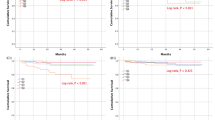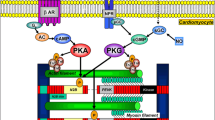Abstract
To determine (a) whether chronic heart failure with reduced ejection fraction (HFrEF) is associated with increased glycocalyx shedding; (b) whether glycocalyx shedding in HFrEF with left ventricular dyssynchrony is related to inflammation, endothelial dysfunction and/or redox stress and is ameliorated by cardiac resynchronisation therapy. Glycocalyx shedding has been reported to be increased in heart failure and is a marker of increased mortality. Its role in dyssynchronous systolic heart failure and the effects of cardiac resynchronisation therapy (CRT) are largely unknown. Twenty-six patients with dyssynchronous HFrEF were evaluated before and 6 months after CRT insertion. Echocardiographic septal to posterior wall delay (SPWD) assessed intra-ventricular mechanical dyssynchrony, and quality of life, integrity of nitric oxide (NO) signalling, inflammatory and redox-related biomarkers were measured. Glycocalyx shedding was quantitated via plasma levels of the glycocalyx component, syndecan-1. Syndecan-1 levels pre-CRT were inversely correlated with LVEF (r = − 0.45, p = 0.02) and directly with SPWD (r = 0.44, p = 0.02), QOL (r = 0.39, p = 0.04), plasma NT-proBNP (r = 0.43, p = 0.02), and the inflammatory marker, symmetric dimethylarginine (SDMA) (r = 0.54, p = 0.003). On multivariate analysis, syndecan-1 levels were predicted by SPWD and SDMA (β = 0.42, p = 0.009 and β = 0.54, p = 0.001, respectively). No significant correlation was found between syndecan-1 levels and other markers of endothelial dysfunction/inflammatory activation. Following CRT there was no significant change in syndecan-1 levels. In patients with dyssynchronous HFrEF, markers of glycocalyx shedding are associated with the magnitude of mechanical dyssynchrony and elevation of SDMA levels and inversely with LVEF. However, CRT does not reverse this process.



Similar content being viewed by others
Abbreviations
- CRT:
-
Cardiac resynchronisation therapy
- SPWD:
-
Septal to posterior wall delay
- QOL:
-
Quality of life
- LVEF:
-
Left ventricular ejection fraction
- NT-proBNP:
-
N-terminal pro-B-type natriuretic peptide
- AIX :
-
Augmentation index
- NO:
-
Nitric oxide
- SDMA:
-
Symmetric dimethylarginine
- TXNIP:
-
Thioredoxin interacting protein
References
Krum H, Abraham WT (2009) Heart failure. Lancet 373:941–955
Candia AM, Villacorta H Jr, Mesquita ET (2007) Immune-inflammatory activation in heart failure. Arq Bras Cardiol 89(183–190):188–201
Katz SD, Hryniewicz K, Hriljac I, Balidemaj K, Dimayuga C, Hudaihed A, Yasskiy A (2005) Vascular endothelial dysfunction and mortality risk in patients with chronic heart failure. Circulation 111:310–314
Ferrari R, Bachetti T, Agnoletti L, Comini L, Curello S (1998) Endothelial function and dysfunction in heart failure. Eur Heart J 19 Suppl G: G41–47.
Kolarova H, Ambruzova B, Svihalkova Sindlerova L, Klinke A, Kubala L (2014) Modulation of endothelial glycocalyx structure under inflammatory conditions. Mediators Inflamm 2014:694312
Mulivor AW, Lipowsky HH (2009) Inhibition of glycan shedding and leukocyte-endothelial adhesion in postcapillary venules by suppression of matrixmetalloprotease activity with doxycycline. Microcirculation 16:657–666
Lipowsky HH (2012) The endothelial glycocalyx as a barrier to leukocyte adhesion and its mediation by extracellular proteases. Ann Biomed Eng 40:840–848
Cleland JG, Daubert JC, Erdmann E, Freemantle N, Gras D, Kappenberger L, Tavazzi L (2005) The effect of cardiac resynchronization on morbidity and mortality in heart failure. N Engl J Med 352:1539–1549
Bristow MR, Saxon LA, Boehmer J, Krueger S, Kass DA, De Marco T, Carson P, DiCarlo L, DeMets D, White BG, DeVries DW, Feldman AM (2004) Cardiac-resynchronization therapy with or without an implantable defibrillator in advanced chronic heart failure. N Engl J Med 350:2140–2150
Pouleur AC, Knappe D, Shah AM, Uno H, Bourgoun M, Foster E, McNitt S, Hall WJ, Zareba W, Goldenberg I, Moss AJ, Pfeffer MA, Solomon SD (2011) Relationship between improvement in left ventricular dyssynchrony and contractile function and clinical outcome with cardiac resynchronization therapy: the MADIT-CRT trial. Eur Heart J 32:1720–1729
Chung ES, Leon AR, Tavazzi L, Sun JP, Nihoyannopoulos P, Merlino J, Abraham WT, Ghio S, Leclercq C, Bax JJ, Yu CM, Gorcsan J 3rd, St John Sutton M, De Sutter J, Murillo J (2008) Results of the predictors of response to CRT (PROSPECT) trial. Circulation 117:2608–2616
Enomoto K, Yamabe H, Toyama K, Matsuzawa Y, Yamamuro M, Uemura T, Morihisa K, Iwashita S, Kaikita K, Sugiyama S, Ogawa H (2011) Improvement effect on endothelial function in patients with congestive heart failure treated with cardiac resynchronization therapy. J Cardiol 58:69–73
Yufu K, Shinohara T, Ebata Y, Ayabe R, Fukui A, Okada N, Nakagawa M, Takahashi N (2015) Endothelial function predicts new hospitalization due to heart failure following cardiac resynchronization therapy. Pacing Clin Electrophysiol 38:1260–1266
Warriner DR, Lawford P, Sheridan PJ (2016) Measures of endothelial dysfunction predict response to cardiac resynchronisation therapy. Open Heart 3:e000391
Curry FE, Adamson RH (2012) Endothelial glycocalyx: permeability barrier and mechanosensor. Ann Biomed Eng 40:828–839
Neves FM, Meneses GC, Sousa NE, Menezes RR, Parahyba MC, Martins AM, Liborio AB (2015) Syndecan-1 in acute decompensated heart failure-association with renal function and mortality. Circ J 79:1511–1519
Tromp J, van der Pol A, Klip IT, de Boer RA, Jaarsma T, van Gilst WH, Voors AA, van Veldhuisen DJ, van der Meer P (2014) Fibrosis marker syndecan-1 and outcome in patients with heart failure with reduced and preserved ejection fraction. Circ Heart Fail 7:457–462
Wang X-Q, Nigro P, World C, Fujiwara K, Yan C, Berk BC (2012) Thioredoxin interacting protein promotes endothelial cell inflammation in response to disturbed flow by increasing leukocyte adhesion and repressing kruppel-like factor 2. Circ Res 110:560–568
Lang RM, Badano LP, Mor-Avi V, Afilalo J, Armstrong A, Ernande L, Flachskampf FA, Foster E, Goldstein SA, Kuznetsova T, Lancellotti P, Muraru D, Picard MH, Rietzschel ER, Rudski L, Spencer KT, Tsang W, Voigt JU (2015) Recommendations for cardiac chamber quantification by echocardiography in adults: an update from the American Society of Echocardiography and the European Association of Cardiovascular Imaging. J Am Soc Echocardiogr 28(1–39):e14
Pitzalis MV, Iacoviello M, Romito R, Massari F, Rizzon B, Luzzi G, Guida P, Andriani A, Mastropasqua F, Rizzon P (2002) Cardiac resynchronization therapy tailored by echocardiographic evaluation of ventricular asynchrony. J Am Coll Cardiol 40:1615–1622
Kelly R, Hayward C, Avolio A, O'Rourke M (1989) Noninvasive determination of age-related changes in the human arterial pulse. Circulation 80:1652–1659
Hayward CS, Kraidly M, Webb CM, Collins P (2002) Assessment of endothelial function using peripheral waveform analysis: a clinical application. J Am Coll Cardiol 40:521–528
Procter N, Goh V, Mahadevan G, Stewart S, Horowitz J (2016) Platelet reactivity is independent of left atrial wall deformation in patients with atrial fibrillation. Mediators Inflamm 2016:9754808
Heresztyn T, Worthley MI, Horowitz JD (2004) Determination of l-arginine and NG, NG- and NG, NG′-dimethyl-l-arginine in plasma by liquid chromatography as AccQ-Fluor™ fluorescent derivatives. J Chromatogra B Analyt Technol Biomed Life Sci 805:325–329
Chirkov YY, Holmes AS, Chirkova LP, Horowitz JD (1999) Nitrate resistance in platelets from patients with stable angina pectoris. Circulation 100:129–134
Çekiç C, Kırcı A, Vatansever S, Aslan F, Yılmaz HE, Alper E, Arabul M, Sarıtaş Yüksel E, Ünsal B (2015) Serum Syndecan-1 levels and its relationship to disease activity in patients with Crohn's disease. Gastroenterol Res Pract 2015:850351
Lipowsky HH, Lescanic A (2013) The effect of doxycycline on shedding of the glycocalyx due to reactive oxygen species. Microvasc Res. https://doi.org/10.1016/j.mvr.2013.1007.1004
Mochizuki S, Vink H, Hiramatsu O, Kajita T, Shigeto F, Spaan JA, Kajiya F (2003) Role of hyaluronic acid glycosaminoglycans in shear-induced endothelium-derived nitric oxide release. Am J Physiol Heart Circ Physiol 285:H722–726
Zhang X, Xie Y-W, Nasjletti A, Xu X, Wolin MS, Hintze TH (1997) ACE inhibitors promote nitric oxide accumulation to modulate myocardial oxygen consumption. Circulation 95:176
Kalinowski L, Dobrucki LW, Szczepanska-Konkel M, Jankowski M, Martyniec L, Angielski S, Malinski T (2003) Third-generation β-blockers stimulate nitric oxide release from endothelial cells through ATP efflux. Circulation 107:2747
Nguyen TH, Liu S, Ong G, Stafford I, Frenneaux M, Horowitz JD (2016) Abstract 11912: glycocalyx shedding is markedly increased during acute phase of takotsubo cardiomyopathy. Circulation 134:A11912
Hall C (2005) NT-ProBNP: the mechanism behind the marker. J Card Fail 11:S81–S83
Schepers E, Glorieux G, Dhondt A, Leybaert L, Vanholder R (2009) Role of symmetric dimethylarginine in vascular damage by increasing ROS via store-operated calcium influx in monocytes. Nephrol Dial Transplant 24:1429–1435
Kielstein JT, Salpeter SR, Bode-Boeger SM, Cooke JP, Fliser D (2006) Symmetric dimethylarginine (SDMA) as endogenous marker of renal function–a meta-analysis. Nephrol Dial Transplant 21:2446–2451
Sverdlov AL, Chan WP, Procter NE, Chirkov YY, Ngo DT, Horowitz JD (2013) Reciprocal regulation of NO signaling and TXNIP expression in humans: impact of aging and ramipril therapy. Int J Cardiol 168:4624–4630
Sugiura M, Okada R, Okawa S, Shimada H (1970) Pathohistological studies on the conduction system in 8 cases of complete left bundle branch block. Jpn Heart J 11:5–16
Schepers E, Barreto DV, Liabeuf S, Glorieux G, Eloot S, Barreto FC, Massy Z, Vanholder R (2011) Symmetric dimethylarginine as a proinflammatory agent in chronic kidney disease. Clin J Am Soc Nephrol 6:2374–2383
Acknowledgements
The authors wish to thank Jeanette Stansborough and Irene Stafford for helping out with the logistics of the research. Thanks to Matthew Chapman for the echocardiograms.
Author information
Authors and Affiliations
Corresponding author
Ethics declarations
Conflict of interest
The authors declare that there was no conflict of interest.
Additional information
Publisher's Note
Springer Nature remains neutral with regard to jurisdictional claims in published maps and institutional affiliations.
Rights and permissions
About this article
Cite this article
Ajaero, C.N., Procter, N.E.K., Chirkov, Y.Y. et al. Endothelial dysfunction and glycocalyx shedding in heart failure: insights from patients receiving cardiac resynchronisation therapy. Heart Vessels 35, 197–206 (2020). https://doi.org/10.1007/s00380-019-01481-3
Received:
Accepted:
Published:
Issue Date:
DOI: https://doi.org/10.1007/s00380-019-01481-3




